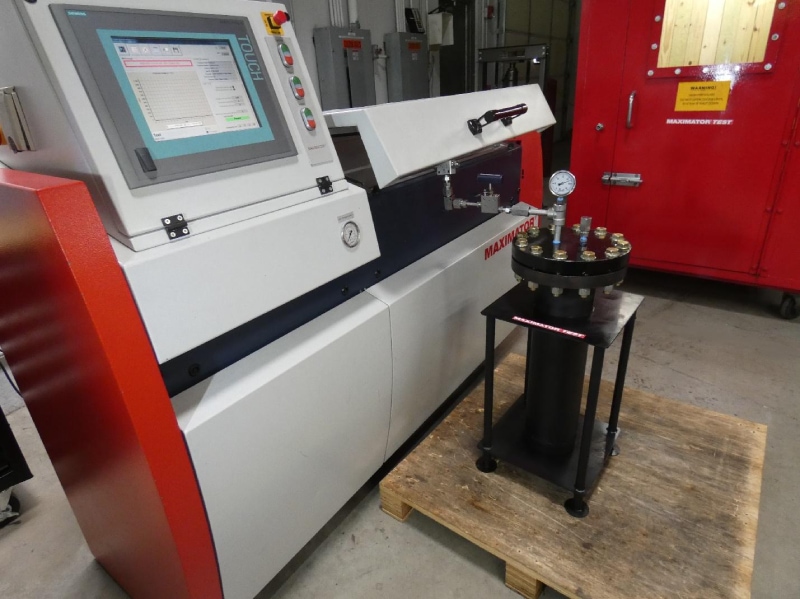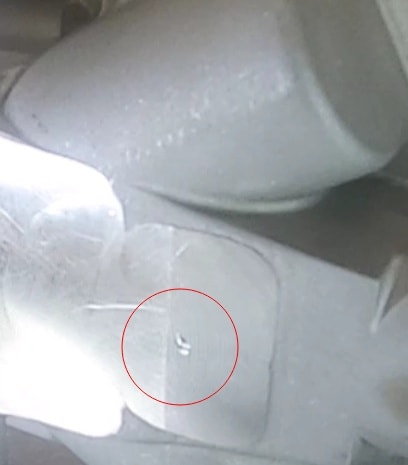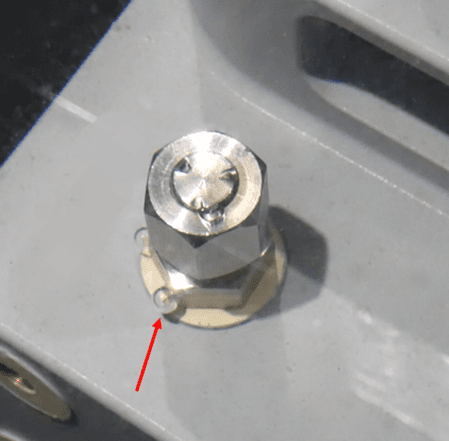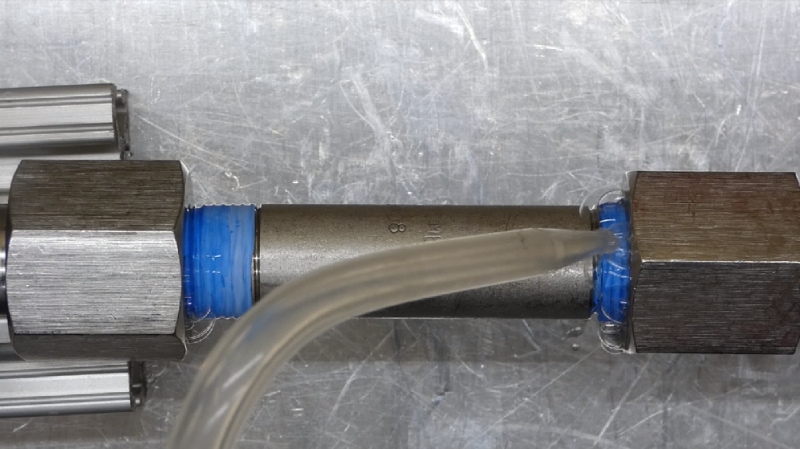Maximator Test® conducts hydrostatic Leak Testing at pressures up to 65,000 psi using water. We can also Leak test to 145,000 psi using hydraulic fluid and up to 11,250 psi using inert gas such as Nitrogen or Helium. Testing is conducted using a plc-controlled and computer regulated test bench, or a manually operated gas booster assembly equipped with NIST traceable pressure gages. The test bench features data acquisition in PDF or CSV format, ISO/IEC 17025 calibrated primary and secondary pressure transducers, and protective safety features. With up to 10-programmable pressure intervals, Maximator Test can assist you with all your Leak Testing needs.
Leak Testing is a versatile testing method that can be crucial in the development and qualification of your product. Leak Testing is a type of testing where the pressure is increased to a specific factor of safety and held for a length of time to determine if any leak paths form, either destructive or non-destructive. There are many methods of Leak Testing offered at Maximator Test to ensure your components are tested to industry standards and will meet the safety requirements of your customers.
Internally pressurized using water or hydraulic fluid as a medium and detecting visual evidence of leakage
Maximator Test® can safely perform Leak Testing on your components by pressurizing the internal cavities using water or hydraulic fluid as a medium and visually inspecting for evidence of ‘leakage’ or droplets of test fluid. The leak will also be present as a drop in pressure on our pressure versus time graph, or calibrated pressure gages, so a leak can be detected quickly in real-time. The leak in the test assembly will then be easily identified to determine the corrective action needed to process future components successfully. With capabilities up to 145,000 psi, Maximator Test can accommodate all your high-pressure Leak Testing needs.
Here is a picture of a pinhole leak found in a casting. This casting was pressurized to a safety factor of 2 using water as a medium and then visually inspected for evidence of leakage. Trust Maximator Test® to accurately locate weak links in your system to help you provide your customers with unrivalled safety.
Internally pressurized using inert gas as a medium and submerging the test component
Sometimes a liquid isn’t adequate to detect leaks visually or there is a concern of internal contamination on the test component. With capabilities up to 11,250 psi using Inert Gas, Maximator Test® can assist with Leak Testing your high-purity components.
This component was submerged in deionized water and pressurized to a safety factor of 1.5. Bubbles formed at the joint indicating a leak in the system. Using a liquid, this leak may be difficult to locate and could be missed before installation. Have confidence in the testing expertise offered at Maximator Test®.
Internally pressurized using inert gas as a medium and using leak detection fluid
If internal or external contamination is of high priority, Maximator Test can perform Leak Testing on your test components up to 11,250 psi using high-purity Inert Gas and Leak Detection Fluid. Maximator Test® will test your components with quality.
This component was pressurized to a safety factor of 3. Bubbles formed at the joints where Leak Detection Fluid was applied, indicating a leak in the system. Submerging the unit could have caused harmful contamination, therefore this method of Leak Testing was chosen. After testing, the unit was dried and wiped clean.
Leak testing at Maximator Test® is conducted with the goal of improving high pressure component designs, identifying the minimum and maximum burst pressures, proving seal or component designs, and locating the source of a failure. Leak testing can show a fundamental fault in the system and high leak rates in specific areas could point to an improperly aligned gasket or valve connections that are misaligned or improperly threaded.
Reasons to Leak Test:
- Validate product design
- Qualify manufacturing methods
- Assure product safety
- Quality control of products offered
Leak Testing Applications:
- High pressure diesel fuel common rails and fuel lines, adapters, fittings
- Vessels, enclosures, ducting, hydraulic hoses, valves, tubes, and other hydraulic products
- Automobile pump brake systems or components, power steering lines
- Shells and tube heat exchangers
- High pressure and ultra-high-pressure hoses, hydraulic pressure hoses
- Comprehensive Test Report
Maximator Test® will provide a comprehensive test report. The report will include:
- An outline of the testing objectives
- The tools and equipment used to conduct the test
- The test set-up and procedure, including photographs of how the setup was completed. In most cases, video recording of the test is also possible.
- Results, including pressure plots, data tables, comments and observations made while conducting the test
- Failure photos showing failure locations
- Calibration certificates




